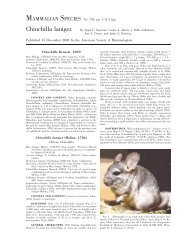Brugia Malayi - Clark Science Center - Smith College
Brugia Malayi - Clark Science Center - Smith College
Brugia Malayi - Clark Science Center - Smith College
Create successful ePaper yourself
Turn your PDF publications into a flip-book with our unique Google optimized e-Paper software.
Temperature-Dependent Regulation of Fimbrial Phase Variation in E. coli<br />
Da Yae Lee<br />
Source: rehydrate.org<br />
How does temperature act as an environmental cue to elicit genotypic and phenotypic responses in bacteria? This summer, as<br />
part of my continuing research in the White-Ziegler lab on the effect of thermoregulation in Escherichia coli, I examined the<br />
dependence of phase variation [P/V] in its fimbrial operons on the temperature of growth. For E. coli strains capable of intestinal<br />
or extraintestinal infections, fimbriae are essential colonization and virulent factors, aiding in bacterial adhesion to and invasion<br />
of host epithelial cells. 1 As energy-expensive as it is to make fimbriae, fimbrial adhesions are tightly regulated in part by phase<br />
variation, or the reversible switching of phenotypes based on protein expression to generate a heterogenic population. 2<br />
For this study involving transcriptional lac fusions of five E. coli fimbrial operons (fan, pap, daa, sfa and fim), two models of<br />
thermoregulation were tested: does temperature act as a precise switch that turns on or off an operon at a defined degree (˚C),<br />
or does it gradually modulate the amount of fimbrial operon transcripts with changing temperature (observed by a change in the<br />
intensity of blue color of the colonies)? For the experiment, E. coli K-12 strain was grown overnight on five M9 X-gal plates at<br />
37˚C, each plate inoculated with a colony of a different fimbrial operon-lac fusion. Of these control colonies, one darkest blue<br />
colony (blue representing P/V ON; white representing P/V OFF) was streaked onto four new X-gal plates, each then incubated<br />
at a new temperature (30, 29, 27 and 25˚C). Once full-sized colonies had grown, the plates were observed for two notable features:<br />
(1) how does the intensity of blue colonies compare to those on other plates and, (2) what is the temperature (if at all) at which<br />
the operon completely turns off?<br />
The fan operon, which is known not to be phase variable, served as the negative control. Across all temperatures, all fan-lac<br />
colonies of the clonal population were blue. At 25˚C, however, all colonies were white, indicating the gene was turned off. Of<br />
the four known phase-varying operons—pap, daa, sfa, and fim—pap- and daa-lac expressing colonies responded to decreasing<br />
temperature with a decreasing intensity of blue, whereas sfa and fim-lac expressing colonies did not show a sign of intensity<br />
change. A common feature was all four phase-varying fimbrial genes seemed to turn off completely by 25˚C, producing all-white<br />
colonies. The results suggest that P/V is turned OFF somewhere between 27 and 25˚C. As for the two models of temperature<br />
regulation proposed, both appear to be at work but affecting different genes. Further studies will attempt to define the critical<br />
temperature at which fimbrial operons are turned off. Also genotypic data using qRT-PCR and microarrays will be used to confirm<br />
these phenotypic results, to describe how temperature modulates the shift from a less virulent (without fimbriae) to virulent (with<br />
fimbriae) lifestyle. (Supported by the National Institute of Health)<br />
Advisor: Christine White-Ziegler<br />
References:<br />
1 Hacker, J. 1992. Role of fimbrial adhesins in the pathogenesis of Escherichia coli infections. Canadian Journal of Microbiology, 38(7): 720-7.<br />
2 Van der Woude, M. W., Bäumler A.J. 2004. Phase and antigenic variation in bacteria. Clinical Microbiology Review, 17 (3): 581-611.<br />
2012<br />
36

















